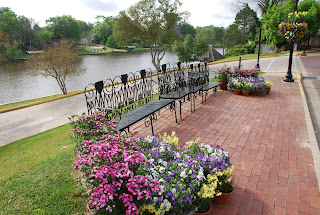 |
| Steel Magnolias House B&B, Natchitoches, LA |
 |
| Natchitoches, Louisiana iron benches |
There are also iron benches that line Canal Street with the names of prominent citizens and businesses from the 1950's and earlier, worked into the back of the bench. Each bench has baskets of flowers nearby, making for a picturesque springtime town. There are a number of old homes in Natchitoches, though unfortunately no explanation of their importance or lineage could be found in the materials we received at the visitor center.
 |
| Oakland Plantation entrance with giant oak trees |
When the Civil War brought decimation and arson to much of the homes by the retreating Union soldiers during the Red River Campaign, Oakland was surprisingly spared, perhaps due to the ingenuity of the women of the house at the time, though the exact reason is lost to the annals of history. One legend is that a quick thinking Mrs. Prud'homme put her children in red caps, a sign of the dreaded scarlet fever. What is not lost to time, though, is all the family history, as the remaining ancestors still live in the area and occasionally drop by to provide firsthand accounts of their life on the plantation (and to argue with each other about the exact stories).
 | |
| Oakland Plantation outbuildings and giant pecan trees with Resurrection ferns |
There were also several other buildings on the property, including an overseer's house, the doctor's house, a number of small barns, a general store, and some original slave quarters. The slave quarters were converted to sharecroppers' homes after emancipation, and then into tenant-farmers' homes. The last tenant-farmer moved out in 1970. The Prud'hommes continued to farm the land until 1984, making this property a certified bi-centennial farm. Wow. And what an unusual family to pass along so much history, knowledge and heirloom antique furniture from one generation to the next without really replacing anything or selling the whole place. The family donated the entire farm with all the furnishings (over 870,000 items!!) to the park service in 1997 to preserve the legacy.
 |
| Brick Slave Quarters at Magnolia Plantation |
We also visited Magnolia Plantation, whose land was granted to the LeCompte family in 1753. Descendants of the family (the Hertzogs) still own the main house and most of the land. The outbuildings have been donated to the National Park Service, however, including eight unusual brick two-room cabins, which replaced the original slave quarters (probably made of wood) in the 1850's or 1860's.
 |
| Gin/Press Barn at Magnolia Plantation |
One interesting tidbit to note about our travels...though we try to eat in local restaurants when we are out and about, we are not always successful in our choices. Let us just say that we have only mentioned in writing those places and meals we actually enjoyed. There have been many, many others whose selection we made without consulting locals or referencing Yelp, and whose 'food', poor service, deplorable conditions, etc we have not enjoyed. Some meals in the last few days, as in some other states, have fallen into this category. Yuck.
No comments:
Post a Comment